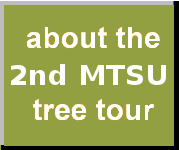
|

|

|

|
An individual instance of Magnolia grandiflora (southern magnolia)
Permanent unique identifier for this particular organism:
http://bioimages.vanderbilt.edu/mtsu/5
Notes:
Description
Southern magnolia is a flowering, woody evergreen tree, with a straight, light brown/gray-brown trunk with scales that are pressed close together. It has a conical crown that grows approximately 50-90 feet tall and 2-4 feet in diameter; and it may live 80-120 years (Maisenhelder, 1970). Sweetbay magnolia (Magnolia virginiana) is similar in appearance, but has a smaller circumference and shorter height. Southern magnolia has moderately stout twigs that have brown wooly hairs. The 5-8 in (13-20 cm) long, 2-3 in (5-8 cm) leaves are simple, alternate, and oval to elliptical. They are very thick and leathery, without teeth, and have a smooth, shiny surface above and a fuzzy, rusty color below. The tree flowers from late spring to fall; producing 6-8 in (15-20 cm) wide fragrant, showy, white, monoecious flowers (having male and female reproductive organs on same plant) on stout, hairy stalks. The flowers may have 6-15 petals. The seeds of the fruit are bright red in color.
Uses
Timber/wood: Southern magnolia is the hardest and heaviest of the magnolia species most commonly harvested in the US. Its wood is hard, heavy, even textured, and similar to yellow poplar in color and properties. It is used for furniture, cabinets, paneling, veneer, boxes, and crates (Maisenhelder, 1970; Hodges et al., 2010).
Urban forestry/ornamental/shade: Southern magnolia is a very popular ornamental shade tree that is used extensively in the south. Southern magnolia is promoted as a hurricane/storm resistant tree in urban areas, right-of-ways, parks, and yards and as an alternative to the once-popular Bradford pair (Pyrus calleryana) and red and silver maples (Acer rubrum; A. saccharinum) which tend to break or topple easily (Brodbeck, 2015).
Wildlife: Seeds are high in fat and are eaten by squirrel, opossum, quail, turkey, mice, and chipmunks and birds. Pollinators, especially beetles, are attracted to the pollen that is high in protein.
Ethnobotany: A variety of extracts have been taken from leaves, fruits, bark, and wood for pharmaceutical applications (Hodges et al., 2010). The Choctaw Indians used the bark to prepare a skin wash for sores, itching, and steambaths (Taylor, 1940).
Seeds and Plant Production
Magnolias are often pollinated by beetles. There is wide variation in bloom times and flower set between cultivars. Although seed production does not start for approximately years, the trees can produce plentiful seed crops each year. Seed dispersal in natural communities may occur through birds, mammals, heavy rains, and winds (Maisenhelder, 1970).
References
Brodbeck, B. (2015). Smart growth in urban forestry; hurricane resistant trees. Urban & Community Forestry. Alabama Coop. Ext. Auburn Univ.
Hodges, J.D., D.L. Evans, L.W. Garnett, A. Londo, and L. McReynolds (2010). Mississippi trees (PDF). Retrieved from http://www.fwrc.msstate.edu/pubs/ms_trees.pdf
Maisenhelder, L.C. (1970). Magnolia: (magnolia grandiflora and magnolia virginiana). American Woods FS-245. USDA Forest Service.
Sheahan, C.M. 2015. Plant guide for southern magnolia (magnolia grandiflora). Retrieved from http://plants.usda.gov/java/factSheet
Taylor, L.A. (1940). Plants used as curatives by certain southeastern tribes. Cambridge, MA: . Botanical Museum of Harvard University.

|

|
|
Load database and switch to thumbnail view
Use this stable URL to link to this page:
http://bioimages.vanderbilt.edu/mtsu/5.htm
This particular organism is believed to have managed means of establishment.
This organismal entity has the scope: multicellular organism.
Identifications:
Magnolia grandiflora
L.
sec. Wofford Chester 2002
common name: southern magnolia
family: Magnoliaceae
Identified 2016-03-13 by Patrick Phoebus
Location:
Alma Mater Dr, Rutledge Hall, Rutherford County, Tennessee, US
Click on these geocoordinates to load a map showing the location: 35.8496°, -86.3699°
Coordinate uncertainty about: 10 m.
Altitude: 192 m.
Location calculated as average of its images' coordinates.
Occurrences were recorded for this particular organism on the following dates:
2016-03-13
The following images document this particular organism.
Click on a thumbnail to view the image and its metadata. Load database and enable navigation by taxon and organism.
| Image | View |
|
|
whole tree (or vine) - general |
|
|
bark - unspecified |
|
|
bark - of a large tree |
|
|
leaf - showing orientation on twig |
|
|
fruit - unspecified |